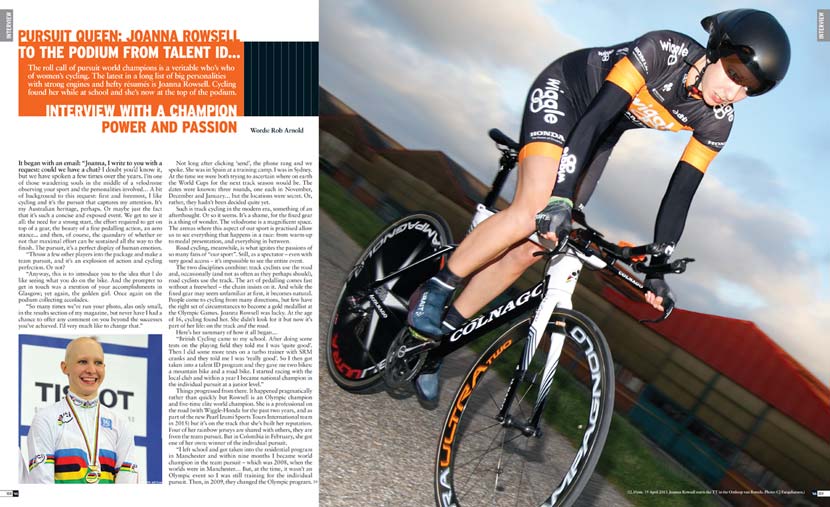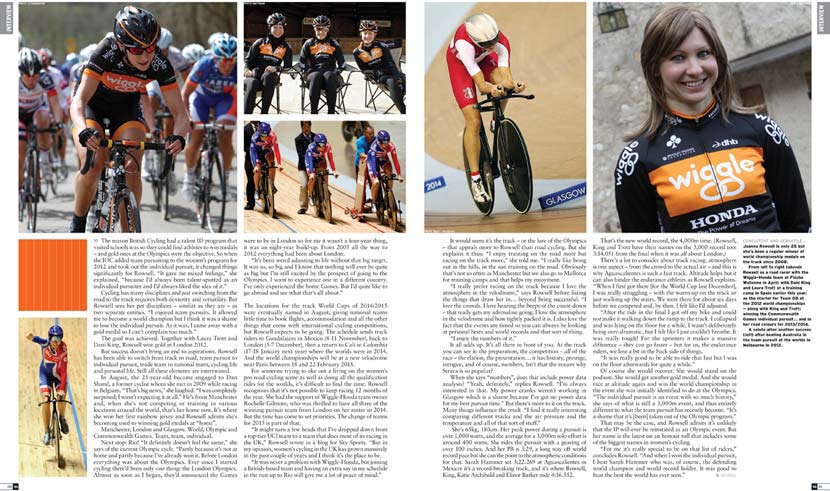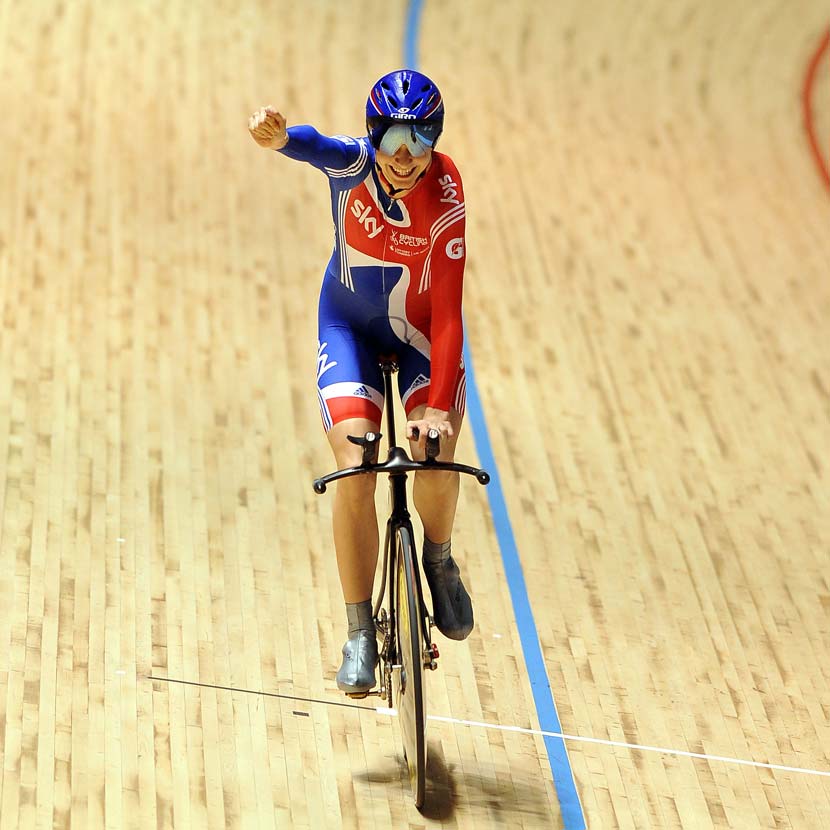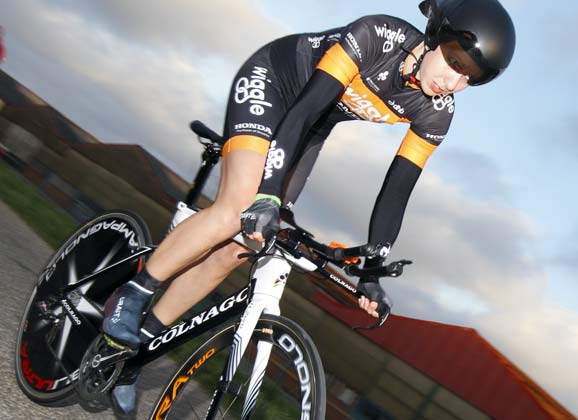The roll call of pursuit world champions is a veritable who’s who of women’s cycling. The latest in a long list of big personalities with strong engines and hefty résumés is Joanna Rowsell. Cycling found her while at school and she’s now at the top of the podium.
(This interview was published in RIDE Cycling Review #65, on sale now in newsagents, bike shops and as an e-magazine via Zinio.)

To the podium from talent ID
– By Rob Arnold
It began with an email: “Joanna, I write to you with a request: could we have a chat? I doubt you’d know it, but we have spoken a few times over the years. I’m one of those wandering souls in the middle of a velodrome observing your sport and the personalities involved… A bit of background to this request: first and foremost, I like cycling and it’s the pursuit that captures my attention. It’s my Australian heritage, perhaps. Or maybe just the fact that it’s such a concise and exposed event. We get to see it all: the need for a strong start, the effort required to get on top of a gear, the beauty of a fine pedalling action, an aero stance… and then, of course, the quandary of whether or not that maximal effort can be sustained all the way to the finish. The pursuit, it’s a perfect display of human emotion.
“Throw a few other players into the package and make a team pursuit, and it’s an explosion of action and cycling perfection. Or not?
“Anyway, this is to introduce you to the idea that I do like seeing what you do on the bike. And the prompter to get in touch was a mention of your accomplishments in Glasgow; yet again, the golden girl. Once again on the podium collecting accolades.
“So many times we’ve run your photo, alas only small, in the results section of my magazine, but never have I had a chance to offer any comment on you beyond the successes you’ve achieved. I’d very much like to change that.”
Not long after clicking ‘send’, the phone rang and we spoke. She was in Spain at a training camp. I was in Sydney. At the time we were both trying to ascertain where on earth the World Cups for the next track season would be. The dates were known: three rounds, one each in November, December and January… but the locations were secret. Or, rather, they hadn’t been decided quite yet.
Such is track cycling in the modern era, something of an afterthought. Or so it seems. It’s a shame, for the fixed gear is a thing of wonder. The velodrome is a magnificent space. The arenas where this aspect of our sport is practised allow us to see everything that happens in a race: from warm-up to medal presentation, and everything in between.
Road cycling, meanwhile, is what ignites the passions of so many fans of “our sport”. Still, as a spectator – even with very good access – it’s impossible to see the entire event.
The two disciplines combine: track cyclists use the road and, occasionally (and not as often as they perhaps should), road cyclists use the track. The art of pedalling comes fast without a freewheel – the chain insists on it. And while the fixed gear may seem unfamiliar at first, it becomes natural. People come to cycling from many directions, but few have the right set of circumstances to become a gold medallist at the Olympic Games. Joanna Rowsell was lucky. At the age of 16, cycling found her. She didn’t look for it but now it’s part of her life: on the track and the road.
Here’s her summary of how it all began…
“British Cycling came to my school. After doing some tests on the playing field they told me I was ‘quite good’. Then I did some more tests on a turbo trainer with SRM cranks and they told me I was ‘really good’. So I then got taken into a talent ID program and they gave me two bikes: a mountain bike and a road bike. I started racing with the local club and within a year I became national champion in the individual pursuit at a junior level.”
Things progressed from there. It happened pragmatically rather than quickly but Rowsell is an Olympic champion and five-time elite world champion. She is a professional on the road (with Wiggle-Honda for the past two years, and as part of the new Pearl Izumi Sports Tours International team in 2015) but it’s on the track that she’s built her reputation. Four of her rainbow jerseys are shared with others, they are from the team pursuit. But in Colombia in February, she got one of her own: winner of the individual pursuit.
“I left school and got taken into the residential program in Manchester and within nine months I became world champion in the team pursuit – which was 2008, when the worlds were in Manchester… But, at the time, it wasn’t an Olympic event so I was still training for the individual pursuit. Then, in 2009, they changed the Olympic program.

The reason British Cycling had a talent ID program that visited schools was so they could find athletes to win medals – and gold ones at the Olympics were the objective. So when the IOC added team pursuiting to the women’s program for 2012 and took out the individual pursuit, it changed things significantly for Rowsell. “It gave me mixed feelings,” she explained, “because I’d always been talent-spotted as an individual pursuiter and I’d always liked the idea of it.”
Cycling has many disciplines and just switching from the road to the track requires both dexterity and versatility. But Rowsell sees her pet disciplines – similar as they are – as two separate entities. “I enjoyed team pursuits. It allowed me to become a world champion but I think it was a shame to lose the individual pursuit. As it was, I came away with a gold medal so I can’t complain too much.”
The goal was achieved. Together with Laura Trott and Dani King, Rowsell won gold in London 2012.
But success doesn’t bring an end to aspirations. Rowsell has been able to switch from track to road, team pursuit to individual pursuit, trade team to national team, cycling life and personal life. Still all these elements are intertwined.
In August, the 25-year-old became engaged to Dan Shand, a former cyclist whom she met in 2009 while racing in Belgium. “That’s big news,” she laughed. “I was completely surprised; I wasn’t expecting it at all.” He’s from Manchester and, when she’s not competing or training in various locations around the world, that’s her home now. It’s where she won her first rainbow jersey and Rowsell admits she’s becoming used to winning gold medals at “home”.
Manchester, London and Glasgow. World, Olympic and Commonwealth Games. Team, team, individual.
Next stop: Rio! “It definitely doesn’t feel the same,” she says of the current Olympic cycle. “Partly because it’s not at home and partly because I’ve already won it. Before London everything was about the Olympics. Ever since I started cycling there’d been only one thing: the London Olympics. Almost as soon as I began, they’d announced the Games were to be in London so for me it wasn’t a four-year thing, it was an eight-year build-up. From 2005 all the way to 2012 everything had been about London.
“It’s been weird adjusting to life without that big target. It was so, so big and I know that nothing will ever be quite as big but I’m still excited by the prospect of going to the Olympics. I want to experience one in a different country. I’ve only experienced the home Games. But I’d quite like to go abroad and see what that’s all about.”
The locations for the track World Cups of 2014/2015 were eventually named in August, giving national teams little time to book flights, accommodation and all the other things that come with international cycling competitions, but Rowsell expects to be going. The schedule sends track riders to Guadalajara in Mexico (8-11 November), back to London (5-7 December), then a return to Cali in Colombia (17-18 January next year) where the worlds were in 2014. And the world championships will be at a new velodrome near Paris between 18 and 22 February 2015.
For someone trying to eke out a living on the women’s pro road cycling scene as well as doing all the qualification rides for the worlds, it’s difficult to find the time. Rowsell recognises that it’s not possible to keep racing 12 months of the year. She had the support of Wiggle-Honda team owner Rochelle Gilmore, who was thrilled to have all three of the winning pursuit team from London on her roster in 2014. But the time has come to set priorities. The change of teams for 2015 is part of that.
“It might turn a few heads that I’ve dropped down from a top-tier UCI team to a team that does most of its racing in the UK,” Rowsell wrote in a blog for Sky Sports. “But in my opinion, women’s cycling in the UK has grown massively in the past couple of years and I think it’s the place to be.
“It was never a problem with Wiggle-Honda, but joining a British-based team and having an extra say in my schedule in the run-up to Rio will give me a lot of peace of mind.”
It would seem it’s the track – or the lure of the Olympics – that appeals more to Rowsell than road cycling. But she explains it thus: “I enjoy training on the road more but racing on the track more,” she told me. “I really like being out in the hills, in the sun training on the road. Obviously that’s not so often in Manchester but we also go to Mallorca for training camps and that helps my enjoyment.
“I really prefer racing on the track because I love the atmosphere in the velodrome,” says Rowsell before listing the things that draw her in… beyond being successful. “I love the crowds. I love hearing the beeps of the count-down – that really gets my adrenaline going. I love the atmosphere in the velodrome and how tightly packed it is. I also love the fact that the events are timed so you can always be looking at personal bests and world records and that sort of thing.
“I enjoy the numbers of it.”
It all adds up. It’s all there in front of you. At the track you can see it: the preparation, the competition – all of the race – the elation, the presentation… it has history, prestige, intrigue, and of course, numbers. Isn’t that the reason why Strava is so popular?
When she says “numbers”, does that include power data analysis? “Yeah, definitely,” replies Rowsell. “I’m always interested in that. My power cranks weren’t working in Glasgow which is a shame because I’ve got no power data for my best pursuit time.” But there’s more to it on the track. Many things influence the result. “I find it really interesting comparing different tracks and the air pressure and the temperature and all of that sort of stuff.”

She’s 65kg, 180cm. Her peak power during a pursuit is over 1,000 watts, and the average for a 3,000m solo effort is around 400 watts. She rides the pursuit with a gearing of over 100 inches. And her PB is 3:29, a long way off world record pace but she can the point to the atmospheric conditions for that. Sarah Hammer set 3:22.269 at Aguascalientes in Mexico: it’s a record-breaking track, and it’s where Rowsell, King, Katie Archibald and Elinor Barker rode 4:16.552.
That’s the new world record, the 4,000m time. (Rowsell, King and Trott have their names on the 3,000 record too: 3:14.051 from the final when it was all about London.)
There’s a lot to consider about track racing: atmosphere is one aspect – from the crowd to the actual air – and this is why Aguascalientes is such a fast track. Altitude helps but it can also hinder the endurance athletes as Rowsell explains. “When I first got there [for the World Cup last December], I was really struggling – with the warm-up on the track or just walking up the stairs. We were there for about six days before we competed and, by then, I felt like I’d adjusted.
“After the ride in the final I got off my bike and could not make it walking down the ramp to the track. I collapsed and was lying on the floor for a while. I wasn’t deliberately being over-dramatic, but I felt like I just couldn’t breathe. It was really tough! For the sprinters it makes a massive difference – they can go faster – but for us, the endurance riders, we lose a bit in the back side of things.
“It was really good to be able to ride that fast but I was on the floor afterwards for quite a while.”
Of course she would recover. She would stand on the podium. She would get another gold medal. And she would race at altitude again and win the world championship in the event she was initially identified to do at the Olympics. “The individual pursuit is an event with so much history,” she says of what is still a 3,000m event, and thus entirely different to what the team pursuit has recently become. “It’s a shame that it’s [been] taken out of the Olympic program.”
That may be the case, and Rowsell admits it’s unlikely that the IP will ever be reinstated as an Olympic event. But her name is the latest on an honour roll that includes some of the biggest names in women’s cycling.
“For me it’s really special to be on that list of riders,” concludes Rowsell. “And when I won the individual pursuit, I beat Sarah Hammer who was, of course, the defending world champion and world record holder. It was good to beat the best the world has ever seen.”
– By Rob Arnold



